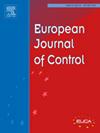Transparency-enhanced observer-based adaptive backstepping torque–position control for teleoperation systems with position error constraint and time-varying delay
IF 2.6
3区 计算机科学
Q2 AUTOMATION & CONTROL SYSTEMS
引用次数: 0
Abstract
Nonlinear teleoperation systems are susceptible to significant problems, including transparency, safety, stability and external torques/forces measurement. In order to deal with these limitations, an observer-based adaptive backstepping torque–position control approach is proposed in this paper. In order to achieve this objective, a novel external torque observer is proposed to alleviate the limitations associated with the use of force sensors. This paper’s main idea is to employ a three-channel architecture using a force sensor-less reflecting signal, which can improve transparency and increase algorithm performance. Furthermore, the another point of this paper is to enhance the safeness of operations in the presence of time-varying delays in the communication channel, a position error constraint control strategy is employed in the core of the proposed approach. Moreover, the primary advantage of this paper is that, the proposed observer-based control algorithm is relieved from the joints acceleration measurement of the leader and follower manipulators which is difficult in robotic systems. Finally, the stability analysis of the controller and observer together is conducted by the Barrier Lyapunov functional and series of simulations, comparisons and practical experiments are performed to validate the performance of the proposed algorithm.
具有位置误差约束和时变延迟的遥操作系统透明性增强观测器自适应反步力矩位置控制
非线性遥操作系统容易受到重大问题的影响,包括透明度,安全性,稳定性和外部扭矩/力测量。为了克服这些局限性,本文提出了一种基于观测器的自适应反步转矩位置控制方法。为了实现这一目标,提出了一种新的外部扭矩观测器,以减轻与使用力传感器相关的局限性。本文的主要思想是采用无力传感器反射信号的三通道架构,可以提高透明度并提高算法性能。此外,本文的另一个重点是为了提高通信信道时变延迟存在时的操作安全性,该方法的核心是位置误差约束控制策略。此外,本文提出的基于观测器的控制算法的主要优点在于,它解决了机器人系统中领导者和从动臂关节加速度测量的难题。最后,利用Barrier Lyapunov泛函对控制器和观测器进行了稳定性分析,并进行了一系列仿真、比较和实际实验,验证了所提算法的性能。
本文章由计算机程序翻译,如有差异,请以英文原文为准。
求助全文
约1分钟内获得全文
求助全文
来源期刊

European Journal of Control
工程技术-自动化与控制系统
CiteScore
5.80
自引率
5.90%
发文量
131
审稿时长
1 months
期刊介绍:
The European Control Association (EUCA) has among its objectives to promote the development of the discipline. Apart from the European Control Conferences, the European Journal of Control is the Association''s main channel for the dissemination of important contributions in the field.
The aim of the Journal is to publish high quality papers on the theory and practice of control and systems engineering.
The scope of the Journal will be wide and cover all aspects of the discipline including methodologies, techniques and applications.
Research in control and systems engineering is necessary to develop new concepts and tools which enhance our understanding and improve our ability to design and implement high performance control systems. Submitted papers should stress the practical motivations and relevance of their results.
The design and implementation of a successful control system requires the use of a range of techniques:
Modelling
Robustness Analysis
Identification
Optimization
Control Law Design
Numerical analysis
Fault Detection, and so on.
 求助内容:
求助内容: 应助结果提醒方式:
应助结果提醒方式:


